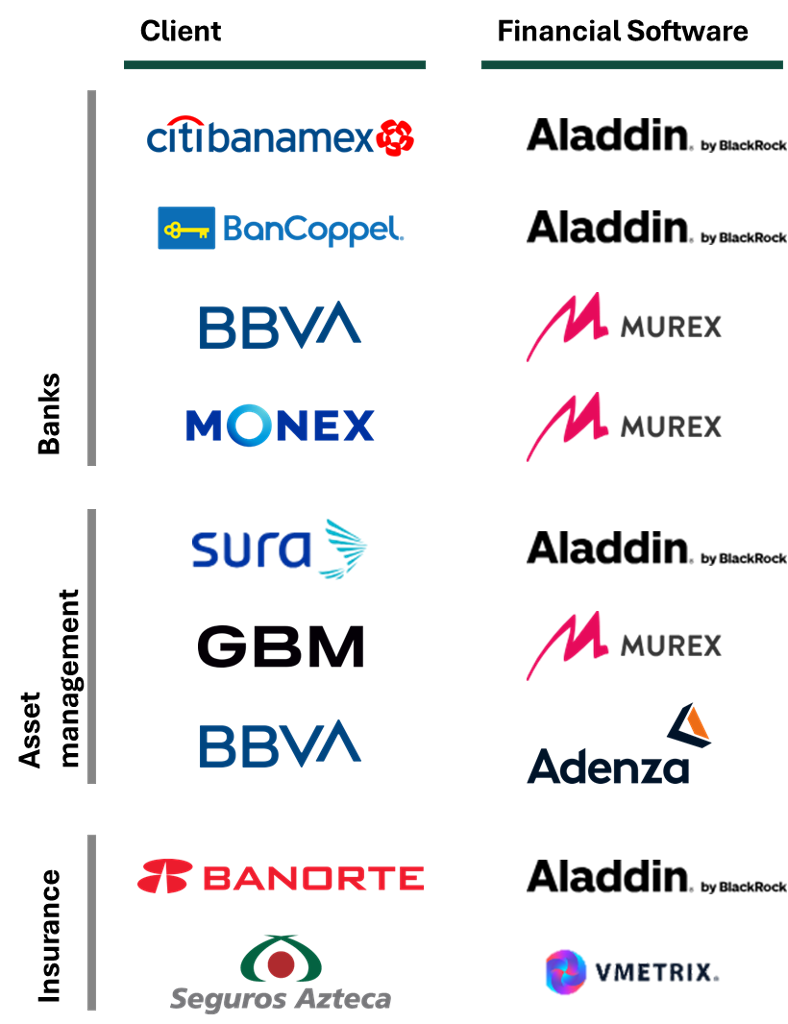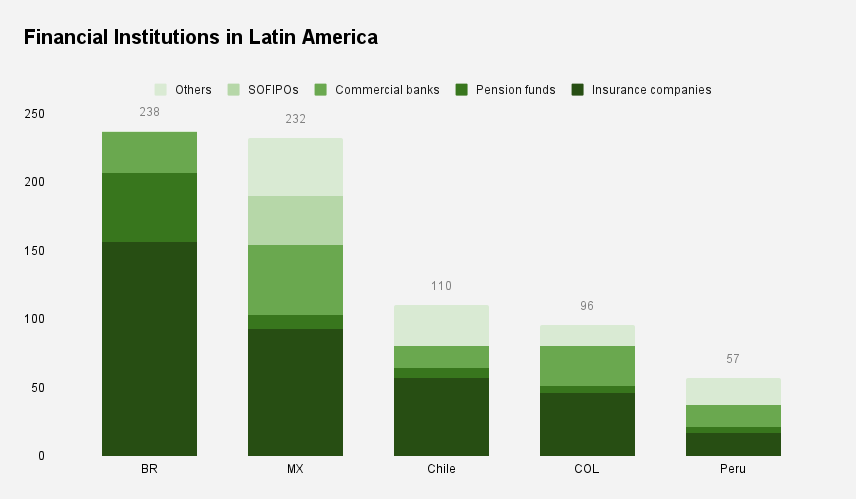The next digital leap of Financial Institutions in Latam
Financial institutions, including banks, insurance companies, and brokerage houses, are at the heart of Latin America's economic growth. Yet, many still operate on fragmented, legacy systems that restrict automation, limit financial instrument access, and complicate risk management. While digital transformation has sped up in the sector — mainly in customer experience, data analytics, and cyber security capabilities — financial institutions have struggled to digitize their core operations due to the high costs and complexity of modernizing legacy infrastructure. Now, a second wave of digital transition is emerging, driven by ongoing digital transformation needs, fintech disruption, increasing financial regulatory requirements, growing needs for real-time data processing and decision-making, and cloud migration. This has raised the demand for integrated, scalable, and cost-effective financial software.
A gap in the market: the opportunity for SaaS
The market for financial software in Latin America has long been dominated by global incumbents such as BlackRock’s Aladdin, Adenza (formerly Calypso, acquired by Nasdaq), and Murex. While these platforms offer powerful tools, they often come with drawbacks: implementation costs in the millions, annual maintenance fees, multi-year implementation cycles, siloed modules, and limited flexibility. BlackRock's Aladdin, for example, requires a $20 million upfront investment and an annual fee of $2 million.
These barriers—combined with Latin America's complex regulatory framework—have kept the technology out of reach for mid-sized financial institutions. As a result, many rely on in-house developments, local providers, or a patchwork of standalone systems and spreadsheets. This has fragmentation has left a clear gap in the market: the need for a complete, cost-effective end-to-end solution.
“Everyone claims they’re end-to-end, but in reality, some are strong in risk, some in front, some in back— there’s no true end-to-end solution. What matters is whether they can adapt to the functionalities each market demands, as in Mexico and Brazil... In fixed income, there’s no such thing as one-size-fits-all. It varies by country, and that’s the hardest part." Executive at a Financial Software Company
Which solutions are Mexican financial institutions choosing?
The Untapped Potential in Latin America
Latin America's financial sector presents a substantial market opportunity for SaaS providers. The region has approximately 733 serviceable financial institutions, including banks, pension funds, asset managers, and insurance companies. By comparison, the UK and Spain combined have 635 institutions, while the US boasts 2,603. Despite these numbers, financial institutions in Latin America have historically been underserved by comprehensive financial technology solutions. Compared to North America and Europe, where SaaS adoption is high, Latin America is still transitioning from legacy systems to cloud-based solutions.
We estimate that this technological gap represents a multi-billion-dollar opportunity in annual contract value as institutions increasingly seek scalable, cost-effective alternatives to traditional software.
A New Standard for Financial Software in LATAM: the case of VMetrix
Enter VMetrix, a rising SaaS challenger that is bridging the technology gap for Latin American financial institutions.
VMetrix provides an end-to-end integrated SaaS solution that unifies front-office trading tools, middle-office risk assessment, and back-office accounting, eliminating the need for disconnected systems. The platform supports a wide range of instruments and built-in connections with data providers that secures local-market specific requirements are met. While competitors require implementation timelines of 3-5 years, VMetrix has managed to reduce implementation timelines to just three months. This speed allows financial institutions to quickly improve operational efficiency, reduce risks, and optimize investment decisions without long, disruptive transitions. Moreover, the company’s subscription-based pricing model (ranging from $600 to $1,800 per user per month) makes it a significantly more affordable solution.
VMetrix’s rapid success in signing clients like Itaú, Credicorp, and Seguros Azteca demonstrates that the market is receptive to a faster, more affordable alternative to legacy solutions. With $1.5 million in ARR from its first six clients and an aggressive planned expansion into Brazil, Colombia, and Peru in 2025, VMetrix is well-positioned to transform the LATAM financial software market.
VMetrix exemplifies the bold entrepreneurial mindset needed to elevate Latin American companies to the global stage. A common challenge for Latin American startups is breaking out of the regional mold. While many companies focus on expansion within LATAM, few take on global markets. VMetrix is changing that narrative. With a high-performance SaaS solution, a scalable go-to-market strategy, and deep industry expertise, it is proving that Latin American fintech can compete on the world stage. The region needs more visionary entrepreneurs willing to build products that not only solve local inefficiencies but also have the potential to scale internationally.
News/Articles
Here are five startups that are running Super Bowl ads this year- Read more
Self Inspection raises $3M for its AI-powered vehicle inspections Read more
Nubank reaches 10M customers in Mexico- Read more
Six ways female founders can accelerate their fintech startups- Read more
AI tax co-pilot TaxGPT secures $4.6m to transform accounting efficiency- Read more
What are we reading to this month?
Range: Why Generalists Triumph in a Specialized World by David Epstein explores the advantages of a broad, diverse skill set over early specialization. Drawing on a range of research from psychology, education, and sports science, Epstein challenges the common belief that early, focused practice is the key to success. Key takeaways include:
A Comprehensive Look at Generalization vs. Specialization: Epstein contrasts the "Tiger Woods model" of early specialization with the "Roger Federer model" of diverse early experiences, arguing that generalists often excel in complex, unpredictable environments.
The Importance of Diverse Experiences: The book emphasizes that trying different fields and skills can lead to better problem-solving and innovation, as generalists can draw on a wide range of knowledge and experiences.
Learning Through Experimentation: Epstein highlights that a trial-and-error approach, where individuals pivot across disciplines, often leads to more creative and adaptable thinking.
The Role of "Slow Learning": Unlike specialists who focus intensely on one area, generalists benefit from slower, more deliberate learning processes, fostering deeper understanding and flexibility.
The Concept of "Match Quality": Epstein introduces the idea that success is often about finding the right fit between an individual’s abilities and their environment, which is more likely when people explore multiple interests before settling.
Applications Across Fields: From sports to business to education, the book illustrates how broad knowledge and interdisciplinary thinking often lead to superior long-term outcomes.
This book offers a compelling argument for the power of flexibility, curiosity, and lifelong learning, encouraging readers to embrace diverse experiences and resist the pressure to specialize too early.
What are we listening to this month?
DeepSeek, China, OpenAI, NVDIA, xAI, TSMC, Stargate, and Megaclusters
Vacancies in portfolio companies
Thank you for reading our monthly newsletter! In this piece we talk about our points of view about the overall market and Latin America, regional news, and what content we are consuming and recommending.
Please make sure to drag this email to your inbox to make sure you keep up to date with our news. If you find this content valuable, don’t forget to





